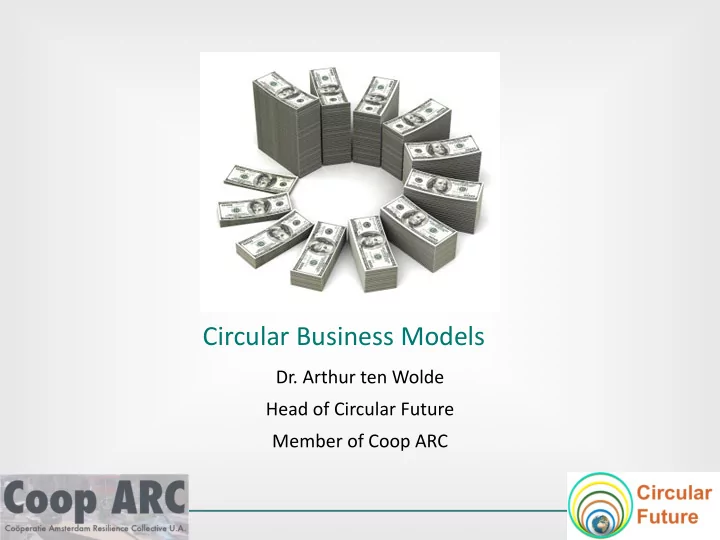

Circular Business Models Dr. Arthur ten Wolde Head of Circular Future Member of Coop ARC
What is a circular economy? • No waste in the environment • redesign, share, production, use, reuse, maintain, repair, refurbish, recycle, 2nd life sales, renewable energy • Performance based contracting • Responsibility shifts • From possession to use • From sustainability to economy • How a company creates, delivers and profits from value added to the economy of tomorrow • 22 business models in 6 categories of circular value creation 2
Innovatie Graph from: ‘Ondernemen in de circulaire economie’, OPAi and MVO Nederland, 2014 3
Advantages circular business models Winnaars Innovation Turnover perspectives Long term contracts Customer loyalty Cost reduction Chain cooperation 4
Opportunities for European Economy • CE could make 3 million jobs by 2030 • Up to 600 billion Euro could be saved per year in EU • CE can lead to resource resilience by saving resources and leave them in there natural base. • CE leads to Waste reduction and reduced environmental impact Sources: European Commission, the Ellen MacArthur Foundation (EMF), WRAP and Accenture 5
22 circular business models in 6 categories 1. Short cycle: Pay per use, repair, waste reduction, sharing platforms, progressive purchase 2. Long cycle: Performance based contracting, maintenance, take back management, next life sales, refurbish & resell, product-based services 3. Cascading: Cascading, recycling, upcycling, collaborative production 4. Pure circles: Cradle to cradle, circular sourcing 5. Digitisation: physical to virtual, subscription based rental 6. Produce on demand: Produce on order, 3D printing, customer vote (design) Source: Coop ARC / Koen van Renswoude, Arthur ten Wolde and Douwe Jan Joustra, Circular Business Models, IMSA Amsterdam, April 2015 6
Category 1: Short cycle Pay per copy 1. Pay per use 2. Repair 3. Waste reduction 4. Sharing platforms 5. Progressive purchase Sharing platforms 7
Category 2: Long cycle 6. Performance based contracting 7. Maintenance 8. Take back management 9. Next life sales 10. Refurbish & resell 11. Product-based services 8
Category 3: Cascading 12. Cascading 13. Recycling 14. Upcycling 15. Collaborative production 9
Category 4: Pure circles 16.Cradle to cradle 17.Circular sourcing 10
Category 5: Digitisation 18. Physical to virtual 19. Subscription based rental 11 Korte cyclus
Category 6: Produce on demand 20. Produce on order 21. 3D printing 22. Customer vote (design) 12 Korte cyclus
Coop ARC Circular Business Scan Value Proposition Design Supply / Procurement Manufacturing Second life Use 13 Korte cyclus
CIRCO Source: Circo, The Netherlands Value Hill 14 Korte cyclus
Main barriers to doing circular business 1. Lack of demand pull for circular products and services, especially from public procurement 2. Lack of transparency through the value chain 15 Korte cyclus
Main asks for a strong EU Circular Economy Package • Overall: Market pull measures & design requirements driving innovation to circular products and services • Clear price incentives for producers and consumers: Extended Producer Responsibility (EPR) , VAT, tax shift • Green Public Procurement: massive training program • Expand Ecodesign directive to circularity for all (end) products • Add ambitious goals for reuse, repair, sharing etc. • Enforcement of existing and smart circular economy regulations • An attractive research programme • Stop EU subsidies for incineration plants until recycling capacity in place 16 Korte cyclus
Improve and expand Extended Producer Responsibility (EPR) • Differentiate levies down to product and company level • Ensure mandatory harmonized criteria • Extend EPR to cover more and more products and sectors • Mandatory investment of the EPR funds in circular economy • Modulated fees may involve other considerations than waste management costs but should be transparent and based on relevant, consistent criteria • Boost ecodesign and secondary raw materials markets 17 Korte cyclus
THANK YOU FOR YOUR ATTENTION Arthur ten Wolde +31 6 1319 6238 arthur.ten.wolde@circular-future.eu
Recommend
More recommend